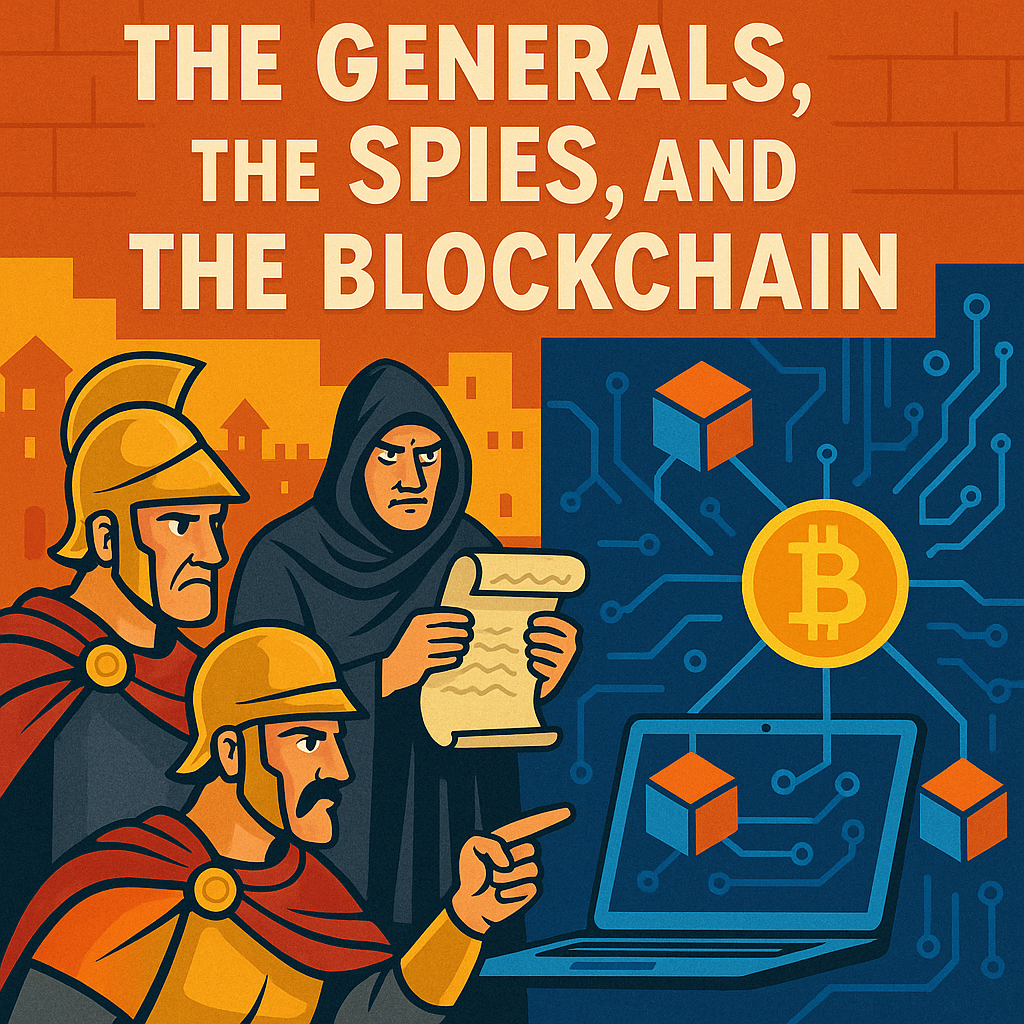The Generals, the Spies, and the Blockchain
A breakdown of the foundational principle that makes decentralized digital money possible.
Imagine a city under siege. You're a general, and you and your fellow generals, all miles apart, need to decide whether to attack or retreat. Your only way to communicate is through messengers, and here's the catch: some of those messengers might be spies for the enemy. In the context of a blockchain, these spies represent malicious computers trying to alter the ledger. How can you be sure the message you're receiving is the real deal and not a trap designed to lead your forces to their doom?

This is a classic thought experiment in computer science known as the Byzantine Generals' Problem. It's a brilliant analogy for a very modern challenge: how do you get a group of independent, decentralized computers to agree on a single, shared truth, especially when some of them might be unreliable or even malicious? The goal of decentralization is to create a system that can operate without a central authority, eliminating any single point of control or failure. This wasn't just a random thought; it was formally defined by computer scientists Leslie Lamport, Robert Shostak, and Marshall Pease, who helped lay the groundwork for understanding how distributed systems could function reliably.
While Bitcoin brilliantly addresses the core challenge of the Byzantine Generals' Problem, it's worth noting that it doesn't achieve "Byzantine Fault Tolerance" in the strictest computer science definition. Traditional Byzantine fault tolerance systems can handle up to one-third of nodes being malicious. Bitcoin's approach is different, it assumes that the majority of computational power (not just the majority of participants) remains honest.
This is the exact issue that had to be solved for cryptocurrencies like Bitcoin to work.
The Problem with Trusting the Crowd
For a cryptocurrency to function, every computer on the network (a "node") needs to agree on a single, shared ledger of every transaction that has ever happened. This is the blockchain.
Without a central bank or governing body to say, "This transaction is valid," how can you prevent someone from spending the same digital coin twice? It's a simple trick for a malicious actor to pull off if the system isn't robust. This is known as a double-spend attack. The network needs a way to achieve consensus and confirm that a transaction is legitimate, even when a portion of the network is actively trying to cheat.
Bitcoin's Brilliant Solution
Bitcoin's creator, the mysterious Satoshi Nakamoto, solved this problem with a clever combination of a few key ideas. It’s a modern-day solution to the Byzantine Generals' Problem.
Digital Signatures
Every transaction is cryptographically signed. This is a general's unforgeable seal on their message. It proves the message came from the coin owner and hasn't been altered. The network can instantly verify that the sender has the right to spend the coins.
Proof of Work
Instead of just voting, the network uses a process called mining, where participants don't simply cast votes but must prove they've expended real computational effort. Miners compete to solve a difficult cryptographic puzzle that requires trying billions of different solutions. It's a global lottery where the first one to find the right number wins the right to add the next "block" of transactions to the blockchain, earning both newly minted coins (the block reward) and the transaction fees from all the transactions in that block. This process is intentionally difficult and energy-intensive. It's a way to prove you've done the work, making it incredibly costly for a bad actor to try and create a fake history.
The Longest Chain Rule
The entire network agrees that the real, legitimate blockchain is the one with the most "work" done on it. Because all the honest miners are contributing to the same chain, it will always be longer and grow faster than any fraudulent chain a malicious actor could create. To successfully attack the network and create a false history, you would need to control more than 50% of the network's total mining power (called "hash rate"), not just 50% of the computers on the network, but 50% of the actual computational work being done to secure the blockchain. This is what's known as a 51% attack, and it’s a monumentally expensive and difficult feat to pull off.
It's important to understand that Bitcoin's solution represents a probabilistic approach to consensus rather than an absolute one. The system becomes more secure over time as more blocks are added, making it exponentially more difficult to alter past transactions. This is why most exchanges wait for multiple "confirmations" (additional blocks) before considering a transaction final.
So, when you hear about Byzantine fault tolerance and cryptocurrency, just think back to the generals. It’s the ingenious system that allows a decentralized network to agree on the truth, even when some participants are trying to lie. It’s the very reason Bitcoin and other cryptocurrencies can operate securely without a central authority. It's the ancient wisdom that makes our modern digital money possible.